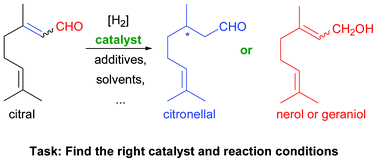Hydrogenation of citral: a wide-spread model reaction for selective reduction of α,β-unsaturated aldehydes
Abstract
![[double bond, length as m-dash]](https://www.rsc.org/images/entities/char_e001.gif) C bond, makes 1 an interesting model compound for catalytic tests in the field of selective
C bond, makes 1 an interesting model compound for catalytic tests in the field of selective

* Corresponding authors
a
Institute for Technical Chemistry and Environmental Chemistry (ITUC), Friedrich-Schiller University, Jena, Lessingstr. 12, D-07743 Jena, Germany
E-mail:
Achim.Stolle@uni-jena.de
Fax: +49 3641 948402
Tel: +49 3641 948413
![[double bond, length as m-dash]](https://www.rsc.org/images/entities/char_e001.gif) C bond, makes 1 an interesting model compound for catalytic tests in the field of selective
C bond, makes 1 an interesting model compound for catalytic tests in the field of selective

 Please wait while we load your content...
Something went wrong. Try again?
Please wait while we load your content...
Something went wrong. Try again?
A. Stolle, T. Gallert, C. Schmöger and B. Ondruschka, RSC Adv., 2013, 3, 2112 DOI: 10.1039/C2RA21498A
To request permission to reproduce material from this article, please go to the Copyright Clearance Center request page.
If you are an author contributing to an RSC publication, you do not need to request permission provided correct acknowledgement is given.
If you are the author of this article, you do not need to request permission to reproduce figures and diagrams provided correct acknowledgement is given. If you want to reproduce the whole article in a third-party publication (excluding your thesis/dissertation for which permission is not required) please go to the Copyright Clearance Center request page.
Read more about how to correctly acknowledge RSC content.
 Fetching data from CrossRef.
Fetching data from CrossRef.
This may take some time to load.
Loading related content
